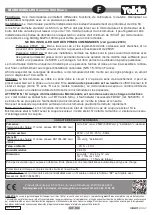
4
Undercurrent unit
The undercurrent unit is intended to be used
for the detection of capacitor disconnection.
With loss of voltage in the feeding bus the ca-
pacitor has to be disconnected from the system
to prevent reapplication of the voltage of the
capacitors before they are fully discharged.
The relay includes a timer (t
rec
), that blocks the
breaker reclosing until the capacitor bank is dis-
charged to an acceptable level for switching in.
The discharge time set value (t
rec
) must be suf-
ficient to prevent reclosing before the capacitor
bank voltage is discharged down to 10% of the
rated voltage. After a loss of auxiliary supply or
whenever powered up, the timer t
rec
is always
started to ensure that the relay will not reclose
the breaker until the capacitor bank is discharged
to an acceptable level. The operation indicator
8 is lit when t
rec
is running.
The stage starts if all the three phase currents
falls below the set level. If the undercurrent con-
dition persists for a time longer than the set
operating time t<, the unit calls for CB trip-
ping by providing a tripping signal. At the same
time the operation indicator is lit with red light
and the display shows a red figure 7. The red
operation indicators remain lit although the
stage resets. The indicators are reset with the
RESET push-button.
The starting current setting range of the stage is
0.10...0.70 x I
n
. The operating time t< is set
within the range 1.0...100 s.
Phase unbalance unit
The purpose of the unbalance protection is to
disconnect a faulty bank to prevent any unit
from being exposed to more than 10% over-
voltage. The protection for capacitor units with
internal fuses can be made with a very high de-
gree of sensitivity, due to the two stage unbal-
ance protection and compensation facility for
natural unbalance.
In the unbalance unit the harmonics are sup-
pressed. The frequency is 50 or 60 Hz.
The phase current unbalance unit includes two
protection stages;
∆
I
1
> and
∆
I
2
>.
If the compensated phase unbalance current
∆
I
c
exceeds the setting value of the stage
∆
I
1
>, the
stage starts and a timer t
∆
I
is started. If the phase
unbalance situation lasts long enough to exceed
the set operating time, the stage provides an
alarm signal. At the same time the display shows
the red figure 4.
If the compensated phase unbalance current
∆
I
c
exceeds the setting value of the stage
∆
I
2
>, the
stage starts and a timer is started. Simultane-
ously it provides a starting signal and the digital
display on the front panel indicates starting with
the red figure 5. The operation time depends
on the degree of unbalance and the inverse time
multiplier k
∆
2
. If the phase unbalance situation
lasts long enough to exceed the operating time,
the stage calls for CB tripping by providing a
tripping signal. At the same time the operation
indicator goes on with a red light and the dis-
play shows the red figure 6. The indicators are
reset with the RESET push-button.
The operation of both phase unbalance stages
can be blocked by bringing a blocking signal
BS1, BS2 or RRES to the unit. The blocking
configuration is set by means of switchgroups
SGB1...3.
The starting setting range of the stage
∆
I
1
> is
1.0...100%
∆
I
n
. The operating time t
∆
1
of the
stage is set separately within the range 1.0...300 s.
The starting setting range of the stage
∆
I
2
> is
2.0...80%
∆
I
n
. The operation of stage
∆
I
2
> is
based on an inverse time characteristic. The in-
verse curve has similar gradient as normal in-
verse. It is possible to increase the inverse charac-
teristic time with a factor 10 by setting SGF/6 to
position 1.
The operation of phase unbalance stage
∆
I
2
> is
provided with a latching facility (SGB1/7) keep-
ing the tripping output energized, although the
signal which caused the operation disappears.
The output relays may be reset in five different
ways; a) by pressing the PROGRAM push-but-
ton, b) by pressing the RESET and PROGRAM
push-buttons simultaneously, by remote con-
trol over the SPA bus using c) the command
V101 or d) the command V102 and further e)
by remote control over the external control in-
put. When resetting according to a) or c) no
stored data are erased, but when resetting ac-
cording to b), d) or e) the recorded data will be
erased.
When phase current I
L1
is under 0.06 x I
n
and
the setting value
∆
I
cs
is different from 0%
∆
I
n
the phase unbalance unit is inert (
∆
I
c
displayed
as n - - - ).
















































